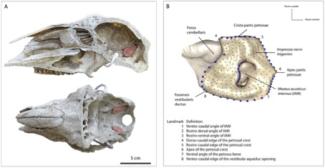
SMEF 11_ Symposium of Morphometrics and Evolution of Shape
30 Juni - 2 July 2021 // Montpellier, France
Oral paper: Bader Camille, Mallet Christophe, Chahoud Jwana, Amane Agraw, De Cupere Bea, Davoudi Hossein, Mohaseb Azadeh, Berthon Rémi, Helmer Daniel, Gourichon Lionel, Mashkour Marjan, Vila Emmanuelle, Cucchi Thomas
Are petrous bones just a repository of ancient molecules? Investigating biosystematic signals in caprine petrous bone using 3D virtual morphology
The petrous bone is the densest bone of the skeleton and fully develop in utero without remodelling throughout the life, making it the ultimate repository of ancient biomolecules, espe- cially endogenous ancient DNA. As such, it has been used widely for biomolecular archaeological studies on human and non-human animals. However, the extent of the demand for destructive analysis of these ancient remains has led to recent pleas for greater caution in the sampling strategy and more ethical curation to safeguard these precious bioarchaeological archives. Be- yond their value as ancient molecules locker, physical anthropology has explored the potential of petrosal bones for sexing and to estimate the foetal age at death, but the use of petrosum in the field of Zooarchaeology has been less explored. Its specific anatomical characteristics have proven useful to reach morphoscopic identification at the species level for closely related species using multivariate morphometrics. However, the intraspecific component of the petrosal bones morphological variation has not been explored yet. Here we propose to investigate the intraspecific taxonomic signal in the petrous bone by using a cross sectional study of its morphological variation in modern populations of sheep breeds and landraces (including wild sheep relatives as well as domestic goats as outgroups), using a 3D Geometric morphometrics protocol on the petrous bone surface to collect size, shape and form datasets. We show here the form is able to detect significant taxonomic signals at both the intra-generic and intra-specific level suggesting that 3D surface capture and GMM analysis of petrous bones could be a prerequisite before destructive biomolecular analysis.